Using Electrical Resistivity Tomography Method to Determine the Inner 3D Geometry and the Main Runoff Directions of the Large Active Landslide of Pie de Cuesta in the Vítor Valley (Peru)
Abstract
:1. Introduction
2. Study Area
2.1. Geological Description of Study Area
2.2. Description of the Landslide through Historical Aerial Imagery
3. Materials and Methods
3.1. Geophysical Non-Invasive Data Acquisition
3.2. Electrical Data Processing
3.3. Seismic Refraction Data Processing
4. Results and Interpretation
4.1. Basis for the Interpretation
- (1)
- Falls. These landslides involve the collapse of materials from a cliff or steep slope. Falls usually involve a mixture of free falls through the air, either bouncing or rolling. A fall-type landslide results in the collection of rock or debris near the base of a slope.
- (2)
- Topples. Topple failures involve the forward rotation and movement of a mass of rock, earth, or debris off a slope. This kind of slope failure generally occurs around an axis (or point) at or near the base of the block of rock.
- (3)
- Flows. Flows are landslides that involve the movement of material down a slope in the form of a fluid. Flows often leave behind a distinctive, upside-down funnel-shaped deposit where the landslide material has stopped moving. There are different types of flows: mud, debris, and rock (rock avalanches).
- (4)
- Rotational and translational slides. Rotational slides occur on curved slip surfaces where the upper surface of the displaced material may tilt backward toward the scarp, whereas a translational (or planar) landslide is a downslope movement of material that occurs along a distinctive planar surface of weakness, such as a fault, joint, or bedding plane. Some of the largest and most damaging landslides on Earth are translational. These landslides occur at all scales and are not self-stabilizing. They can be very rapid when discontinuities are steep.
4.2. Interpretation of the 2D-ERT Profiles
4.3. Interpretation of the 2D-SVP Seismic Profiles
4.4. 3D Subsurface Models
5. Discursion and Conclusions
Author Contributions
Funding
Data Availability Statement
Acknowledgments
Conflicts of Interest
References
- Anis, Z.; Wissem, G.; Riheb, H.; Biswajeet, P.; Essghaier, G.M. Effects of clay properties in the landslides genesis in flysch massif: Case study of Aïn Draham, North Western Tunisia. J. Afr. Earth Sci. 2019, 151, 146–152. [Google Scholar] [CrossRef]
- Clow, D.W.; Schrott, L.; Webb, R.; Campbell, D.H.; Torizzo, A.; Dorblaser, M. Ground water occurrence and contributions to streamflow in an alpine catchment, Colorado Front range. Groundwater 2003, 41, 937–950. [Google Scholar] [CrossRef]
- Garcia-Chevesich, P.; Wei, X.; Ticona, J.; Martínez, G.; Zea, J.; García, V.; Alejo, F.; Zhang, Y.; Flamme, H.; Graber, A.; et al. The Impact of Agricultural Irrigation on Landslide Triggering: A Review from Chinese, English, and Spanish Literature. Water 2021, 13, 10. [Google Scholar] [CrossRef]
- Perrone, A.; Lapena, V.; Piscitelli, S. Electrical resistivity tomography technique for landslide investigation: A review. Earth-Sci. Rev. 2014, 135, 65–82. [Google Scholar] [CrossRef]
- Bichler, A.; Bobrowsky, P.; Best, M.; Douma, M.; Hunter, J.; Calvert, T.; Burns, R. Three-dimensional mapping of a landslide using a multi-geophysical approach: The Quesnel Forks landslide. Landslides 2004, 1, 29–40. [Google Scholar] [CrossRef]
- Jongmans, D.; Hemroulle, P.; Demanet, D.; Renardy, F.; Vanbrabant, Y. Application of 2D electrical and seismic tomography techniques for investigating landslides. Eur. J. Environ. Eng. Geophys. 2000, 5, 75–89. [Google Scholar]
- McCann, D.M.; Forster, A. Reconnaissance geophysical methods in landslide investigations. Eng. Geol. 1990, 29, 59–78. [Google Scholar] [CrossRef]
- Bruno, F.; Marillier, F. Test of high-resolution seismic reflection and other geophysical techniques on the Boup landslide in the Swiss Alps. Surv. Geophys. 2000, 21, 333–348. [Google Scholar] [CrossRef]
- Mauritsch, H.J.; Seiberl, W.; Arndt, R.; Romer, A.; Schneiderbauer, K.; Sendlhofer, G.P. Geophysical investigations of large landslides in the Carnic Region of southern Austria. Eng. Geol. 2000, 56, 373–388. [Google Scholar] [CrossRef]
- Lapenna, V.; Lorenzo, P.; Perrone, A.; Piscitelli, S.; Sdao, F.; Rizzo, E. High-resolution geoelectrical tomographies in the study of the Giarrossa landslide (Potenza, Basilicata). Bull. Eng. Geol. Environ. 2003, 62, 259–268. [Google Scholar] [CrossRef]
- Hood, J.L.; Roy, J.W.; Hayashi, M. Importance of groundwater in the water balance of an alpine headwater lake, Geophys. Res. Lett. 2006, 33, L13405. [Google Scholar] [CrossRef]
- Garrido, J.; Delgado, J. A recent, retrogressive, complex earthflow–earth slide at Cenes de la Vega, southern Spain. Landslides 2013, 10, 83–89. [Google Scholar] [CrossRef]
- Godio, A.; Bottino, G. Electrical and electromagnetic investigation for landslide characterization. Phys. Chem. Earth Part C Sol. Terr. Planet. Sci. 2001, 26, 705–710. [Google Scholar] [CrossRef]
- Shevnin, V.; Delgado-Rodríguez, O.; Mousatov, A.; Ryjov, A. Estimation of hydraulic conductivity on clay content in soil determined from resistivity data. Geofis. Int. 2006, 45, 195–207. [Google Scholar] [CrossRef]
- Khalil, M.A.; Monterio-Santos, F.A. Influence of Degree of Saturation in the Electric Resistivity–Hydraulic Conductivity Relationship. Surv. Geophys. 2009, 30, 601–615. [Google Scholar] [CrossRef]
- Sestras, P.; Bilașco, Ș.; Roșca, S.; Veres, I.; Ilies, N.; Hysa, A.; Spalević, V.; Cîmpeanu, S.M. Multi-Instrumental Approach to Slope Failure Monitoring in a Landslide Susceptible Newly Built-Up Area: Topo-Geodetic Survey, UAV 3D Modelling and Ground-Penetrating Radar. Remote Sens. 2022, 14, 5822. [Google Scholar] [CrossRef]
- U.S. Geological Survey. Landslide Hazards Program. Available online: https://www.usgs.gov/programs/landslide-hazards (accessed on 29 October 2023).
- Sass, O. Bedrock detection and talus thickness assessment in the European Alps using geophysical methods. J. Appl. Geophys. 2007, 62, 254–269. [Google Scholar] [CrossRef]
- Abolmasov, B.; Ristic, A.; Govedaric, M. Applying GPR and 2D ERT for shallow landslides characterization: A case study. In Landslide Science and Practice; Margottini, C., Canuti, P., Sassa, K., Eds.; Springer: Berlin/Heidelberg, Germany, 2013; Volume 2. [Google Scholar] [CrossRef]
- Lghoul, M.; Teixidó, T.; Peña, J.A.; Hakkou, R.; Kchikach, A.; Guerin, R.; Jaffal, M.; Zouhri, L. Electrical and Seismic Tomography Used to Image the Structure of a Tailings Pond at the Abandoned Kettara Mine, Morocco. Mine Water Environ. 2012, 31, 53–61. [Google Scholar] [CrossRef]
- Cahyaningsih, C.; Riau, U.I.; Asteriani, F.; Crensonni, P.F.; Choanji, T. Safety factor characterization of landslide in Riau-West of Sumatra highway. Int. J. Geomate 2019, 17, 323–330. [Google Scholar] [CrossRef]
- Himi, M.; Anton, M.; Sendrós, A.; Abancó, C.; Ercoli, M.; Lovera, R.; Deidda, G.P.; Urruela, A.; Rivero, L.; Casas, A. Application of Resistivity and Seismic Refraction Tomography for Landslide Stability Assessment in Vallcebre, Spanish Pyrenees. Remote Sens. 2022, 14, 6333. [Google Scholar] [CrossRef]
- Huamán, G.E.A.; Pinto, W.P.; Chulla, H.L.O.; Cárdenas, J.H. Geodynamics, Geodetic Monitoring and Geophysical Prospection of the Pie de Cuesta Landslide-Vítor, Arequipa; Mining and Metallurgical Geological Institute-INGEMMET: Lima, Peru, 2018. [Google Scholar]
- Mining and Metallurgical Geological Institute. Monitoring of the Pie de Cuesta Landslide during the 2021 Period, Vitor and La Joya District, Province of Arequipa, Department of Arequipa; Technical Report A7242; INGEMMET: Lima, Peru, 2022; p. 26. [Google Scholar]
- Araujo, G.E.; Miranda, R. Geological and Geodynamic evaluation of landslides on the left flank of the Vitor Valley, Pie de Cuesta, Telaya, Gonzales and Socabón Sectors. Vitor and La Joya Districts, Arequipa Region, Arequipa Province; Mining and Metallurgical Geological Institute-INGEMMET: Lima, Peru, 2016. [Google Scholar]
- Lacroix, P.; Dehecq, A.; Taipe, E. Irrigation-triggered landslides in a Peruvian desert caused by modern intensive farming. Nat. Geosci. 2020, 13, 56–60. [Google Scholar] [CrossRef]
- Huanca, J. Application of the GNSS-RTK Technique and Photogrammetry with Drones for the Characterization and Monitoring of the Pie de Cuesta Active Landslide in the Vitor Valley, Arequipa. Licentiate Thesis, National University of San Agustín of Arequipa, Arequipa, Peru, 2020. [Google Scholar]
- Huerta, V. Rehabilitation of the Mocoro Canal—San Luis in the Pie de la Cuesta Section—La Cano Irrigation—Geological and Geotechnical Study. Licentiate Thesis, National University of San Agustín of Arequipa, Arequipa, Peru, 1977. [Google Scholar]
- Sass, O. Determination of the internal structure of alpine talus deposits using different geophysical methods (Lechtaler Alps, Austria). Geomorphology 2006, 80, 45–58. [Google Scholar] [CrossRef]
- Pazzi, V.; Morelli, S.; Fanti, R. A Review of the Advantages and Limitations of Geophysical Investigations in Landslide Studies. Int. J. Geophys. 2019, 2019, 2983087. [Google Scholar] [CrossRef]
- Emily, E. Brodsky, Evgenii Gordeev, Hiroo Kanamori. Landslide basal friction as measured by seismic waves. Geophys. Res. Lett. 2003, 30, 2236. [Google Scholar] [CrossRef]
- Powers, M.H.; Burton, B.L. Questa Baseline and Pre-Mining Ground-Water Quality Investigation. Seismic Refraction Tomography for Volume Analysis of Saturated Alluvium in the Straight Creek Drainage and Its Confluence with Red River, Taos County, New Mexico: U.S.; Geological Survey Scientific Investigation Report 2006–5166; U.S. Geological Survey: Reston, VA, USA, 2007; p. 19. ISBN 978-94-6282-119-4. [Google Scholar] [CrossRef]
- Griffiths, D.H.; Barker, R.D. Two-dimensional resistivity imaging and modelling in areas of complex geology. J. Appl. Geophys. 1993, 29, 211–226. [Google Scholar] [CrossRef]
- Edwards, L.S. A modified pseudosection for resistivity and IP. Geophysics 1977, 42, 1020–1036. [Google Scholar] [CrossRef]
- Aki, K.; Richards, P.G. Quantitative Seismology: Theory and Methods; W. H. Freeman & Company: San Francisco, CA, USA, 1980; Volume I, p. 557. ISBN 0716710587. [Google Scholar]
- Samouëlian, A.; Cousin, I.; Tabbagh, A.; Bruand, A.; Richard, G. Electrical resistivity survey in soil science: A review. Soil Tillage Res. 2005, 83, 173–193. [Google Scholar] [CrossRef]
- Loke, M.H.; Barker, R.D. Rapid least-squares inversion of apparent resistivity pseudosections by a quasi-Newton method. Geophys. Prospect. 1996, 44, 131–152. [Google Scholar] [CrossRef]
- Loke, M.H. 2-D and 3-D inversion and Modeling of Surface- and Borehole Resistivity Data; United States Geological Survey: Hartford, CT, USA, 2001. [Google Scholar]
- Tarantola, A.; Valette, B. Generalized Nonlinear inverse problems solved using the Least Squares Criterion. Rev. Geophys. 1982, 20, 219–232. [Google Scholar] [CrossRef]
- Gebrande, H.; Miller, H. The DeltatV 1D Method for Seismic Refraction Inversion: Theory; II 226–260. Siegfried R. Rohdewald, 2011; Intelligent Resources Inc.: Manchester, UK, 1985. [Google Scholar]
- Varnes, D.M. Landslide Types and Processes, Transportation Research Board, U.S.; National Academy of Sciences, Special Report; Transportation Research Board: Washington, DC, USA, 1996; Volume 247, pp. 36–57. [Google Scholar]
- Hungr, O.; Leroueil, S.; Picarelli, L. The Varnes classification of landslide types, an update. Landslides 2014, 11, 167–194. [Google Scholar] [CrossRef]
- McInnis, D.; Silliman, S.; Boukari, M.; Yalo, N.; Orou-Pete, S.; Fertenbaugh, C.; Sarre, K.; Fayomi, H. Combined application of electrical resistivity and shallow groundwater sampling to assess salinity in a shallow coastal aquifer in Benin. West Afr. J. Hydrol. 2013, 505, 335–345. [Google Scholar] [CrossRef]
- Lesmes, D.; Friedman, S. Relationships between the Electrical and Hydrogeological Properties of Rocks and Soils. In Hydrogeophysics; Springer: Berlin/Heidelberg, Germany, 2005. [Google Scholar] [CrossRef]
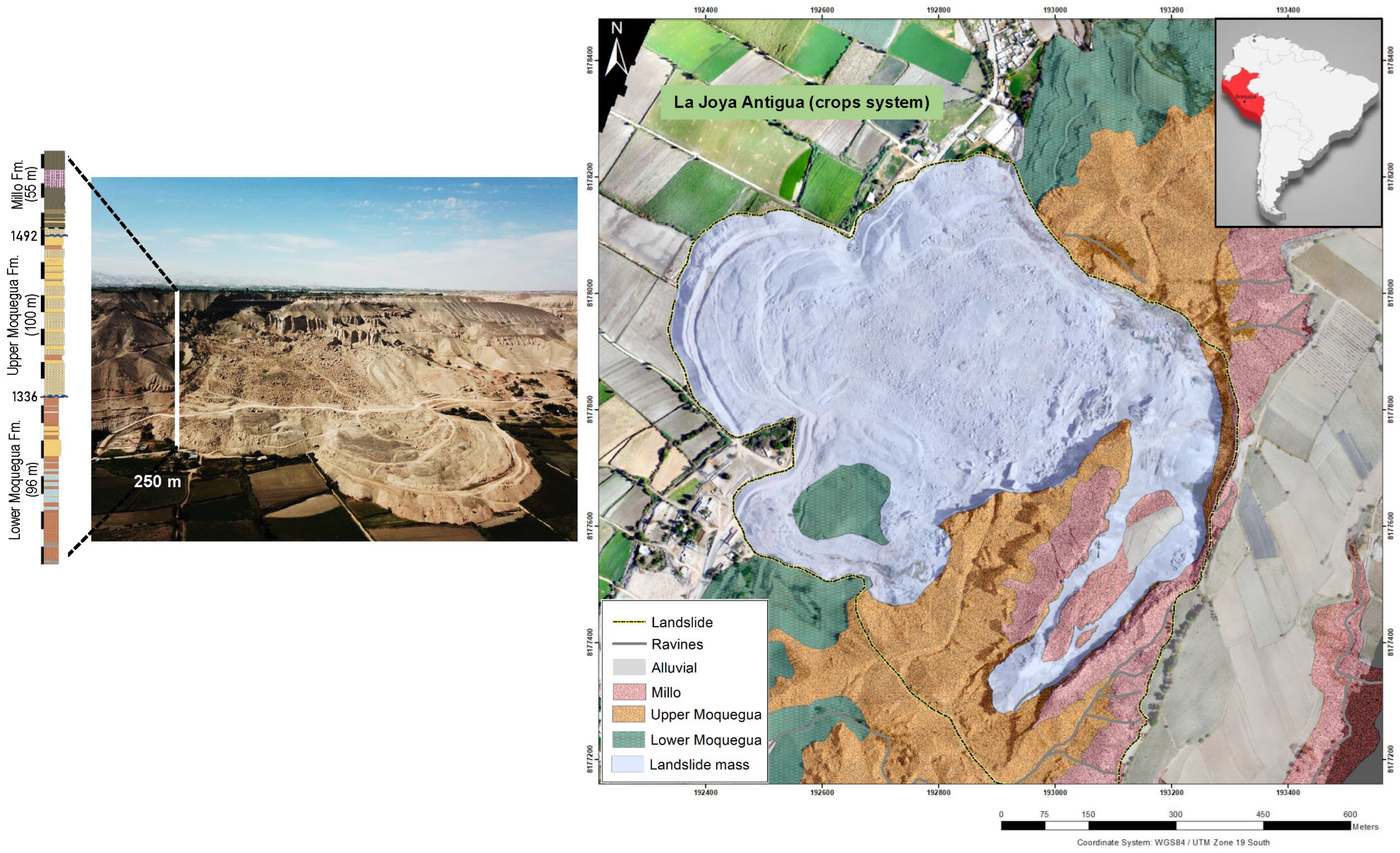

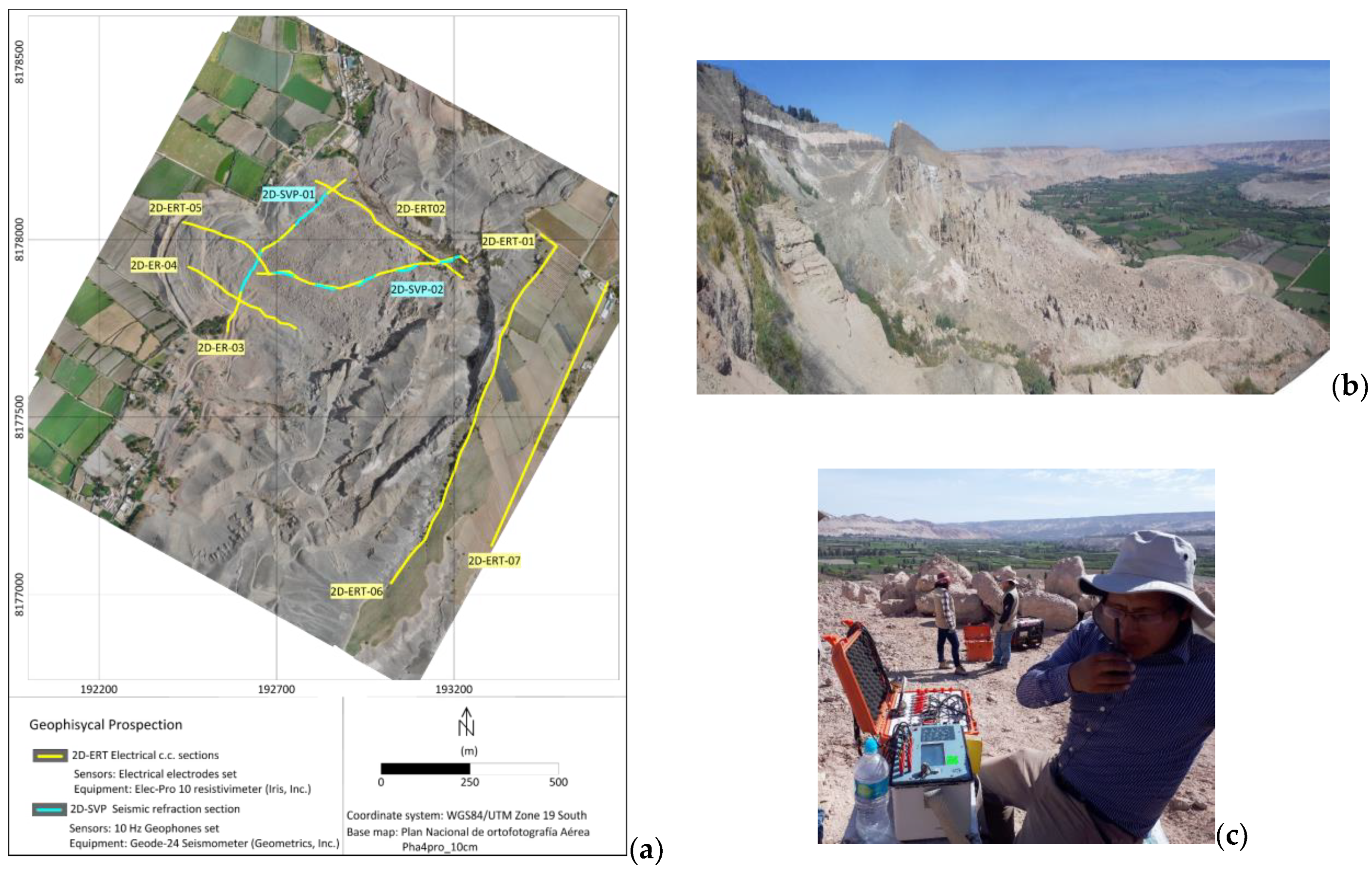
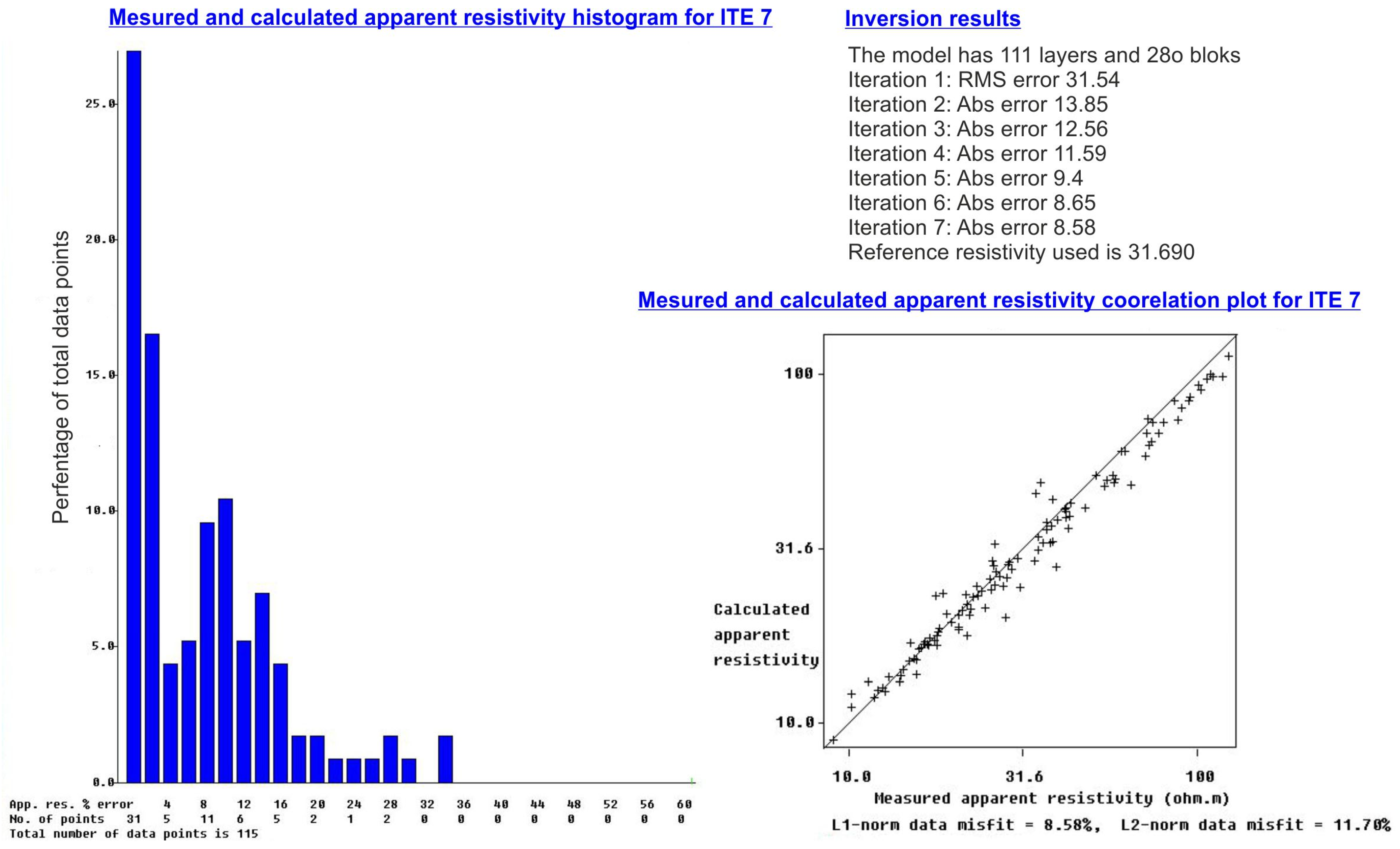
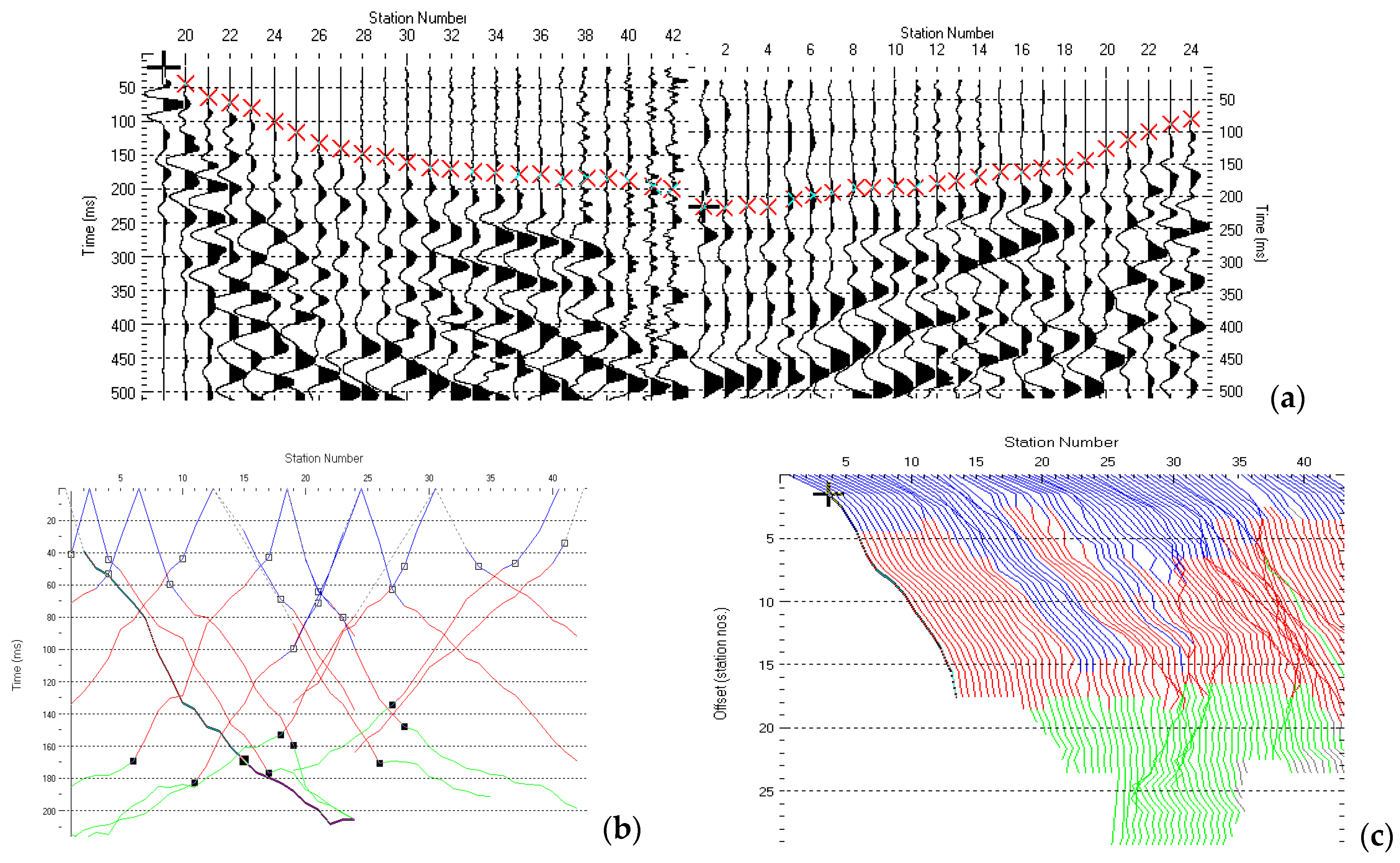
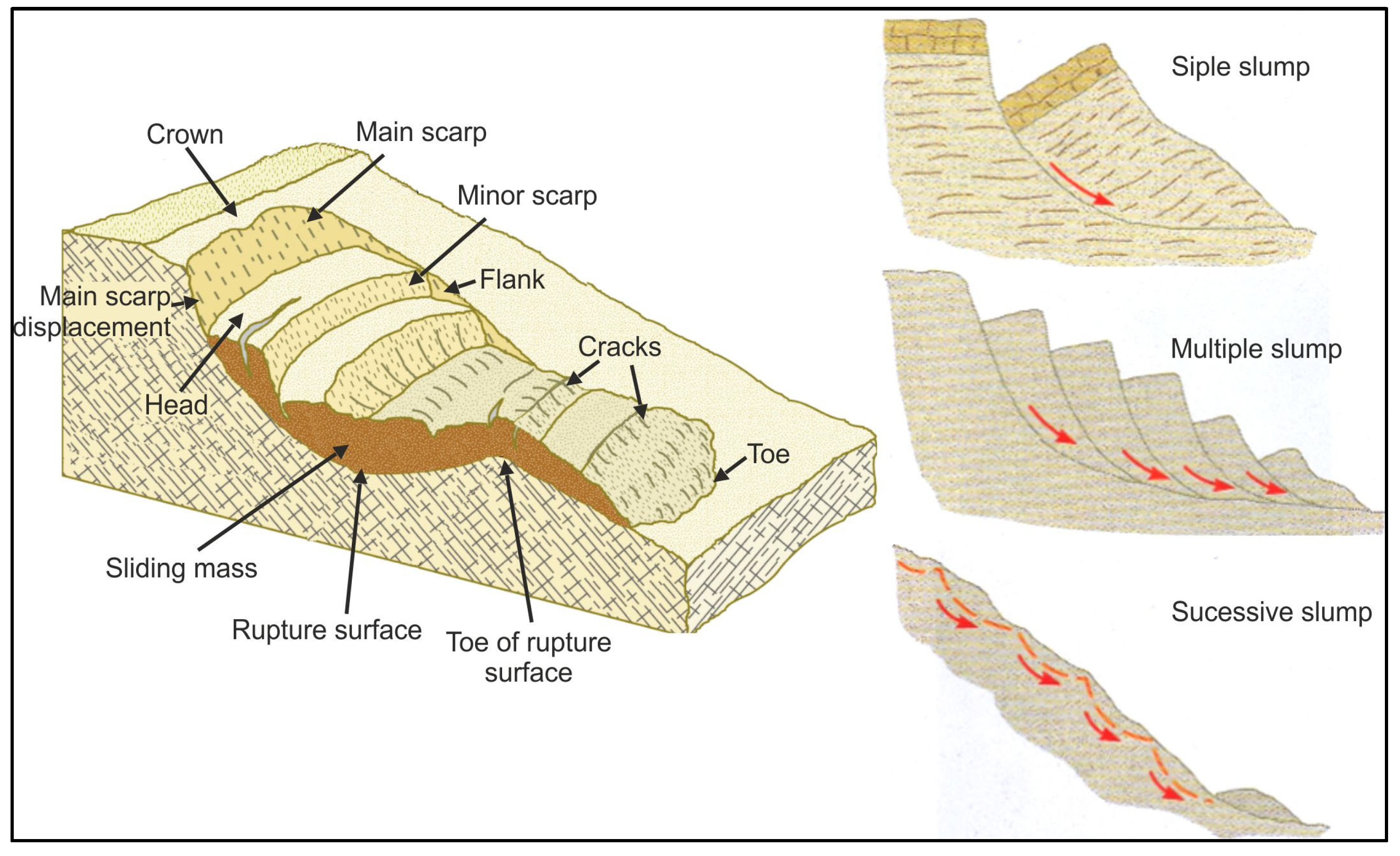
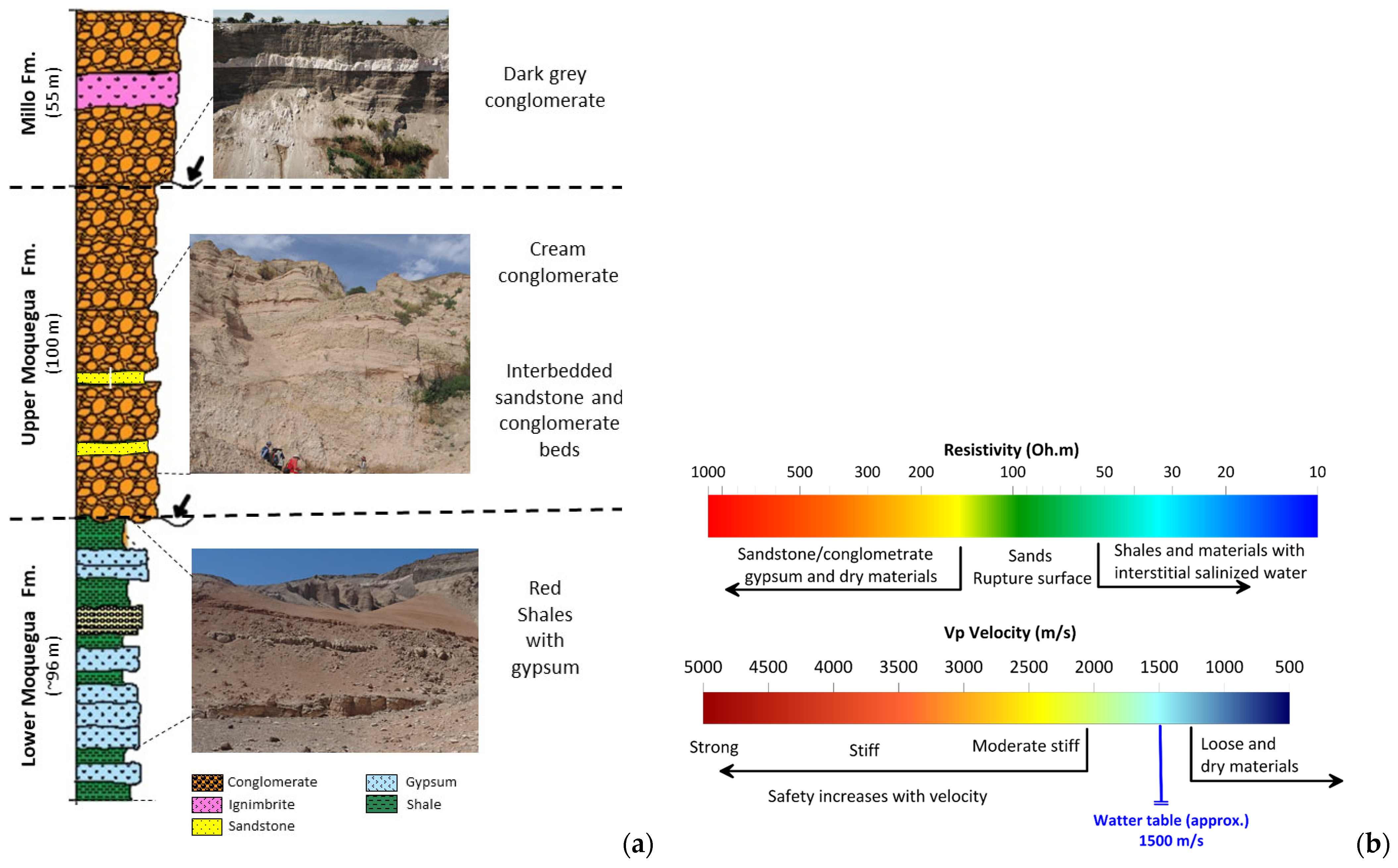
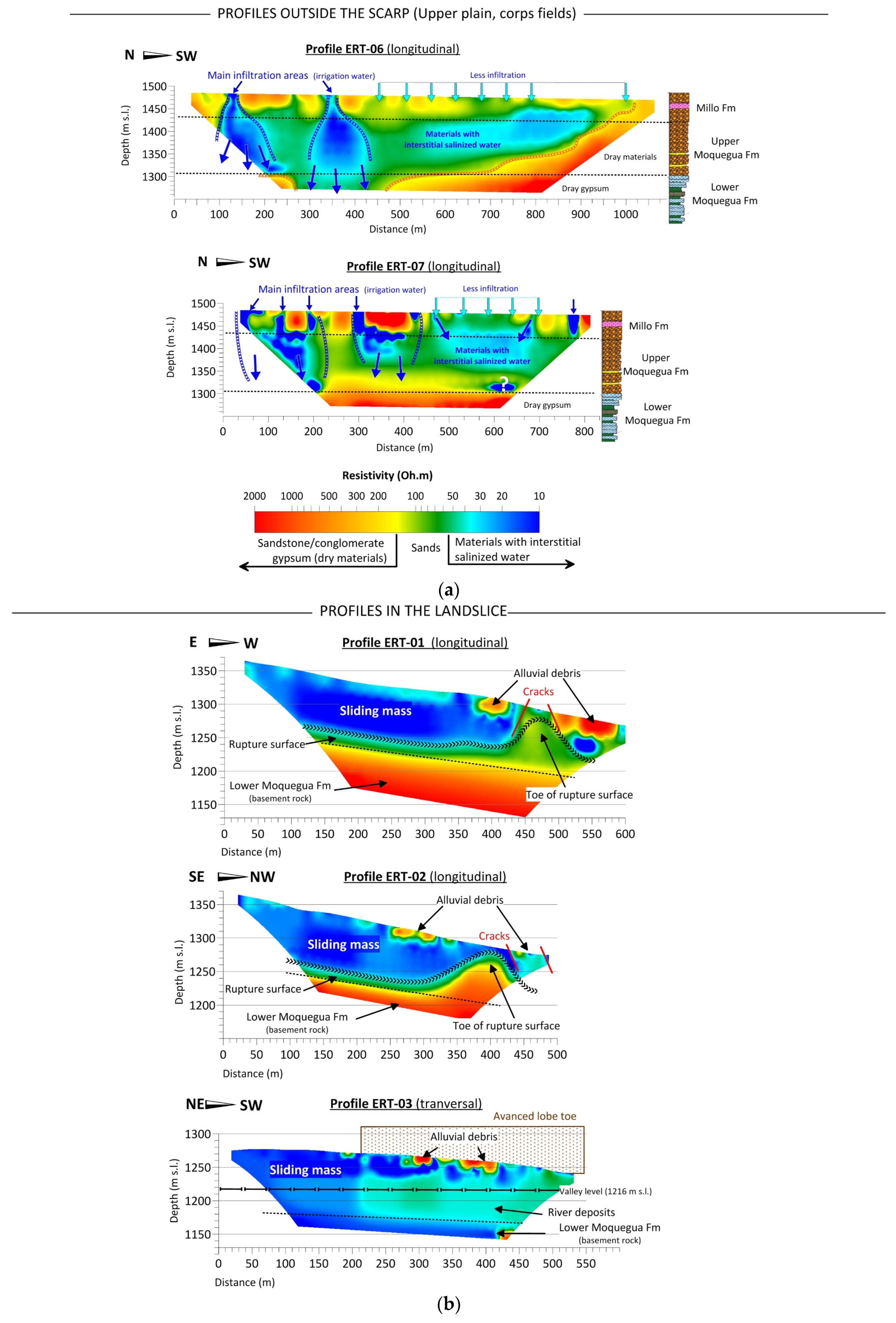

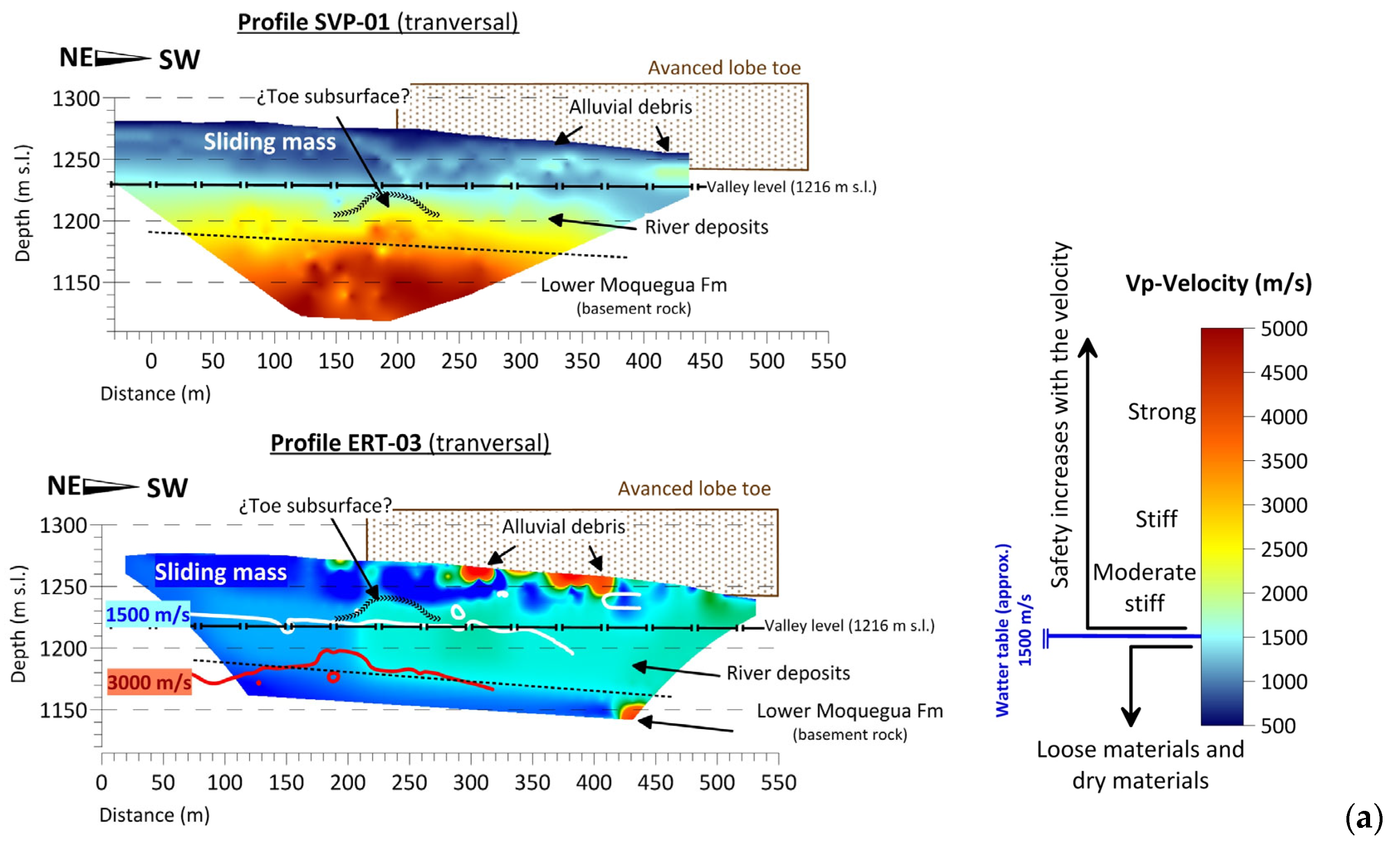
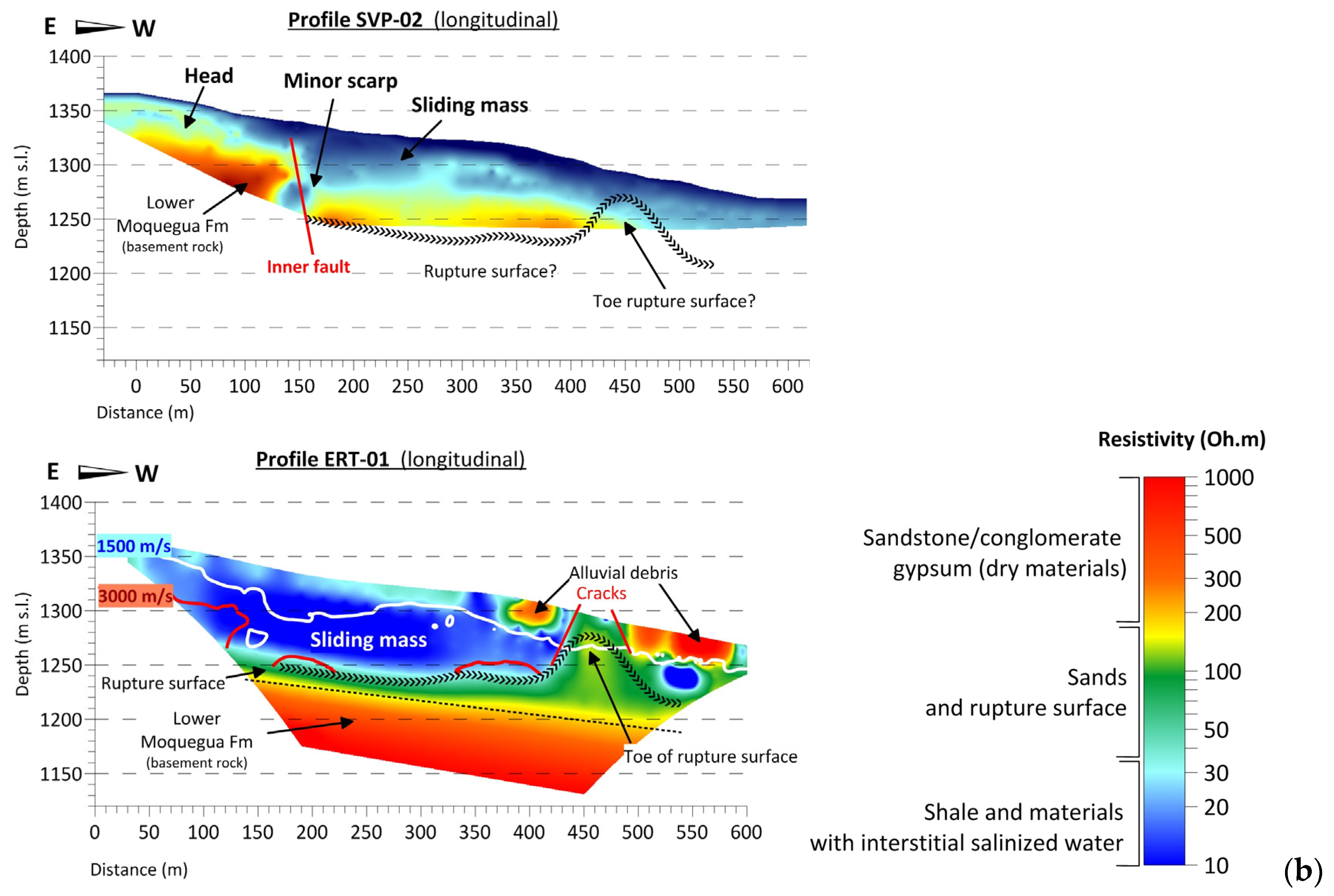
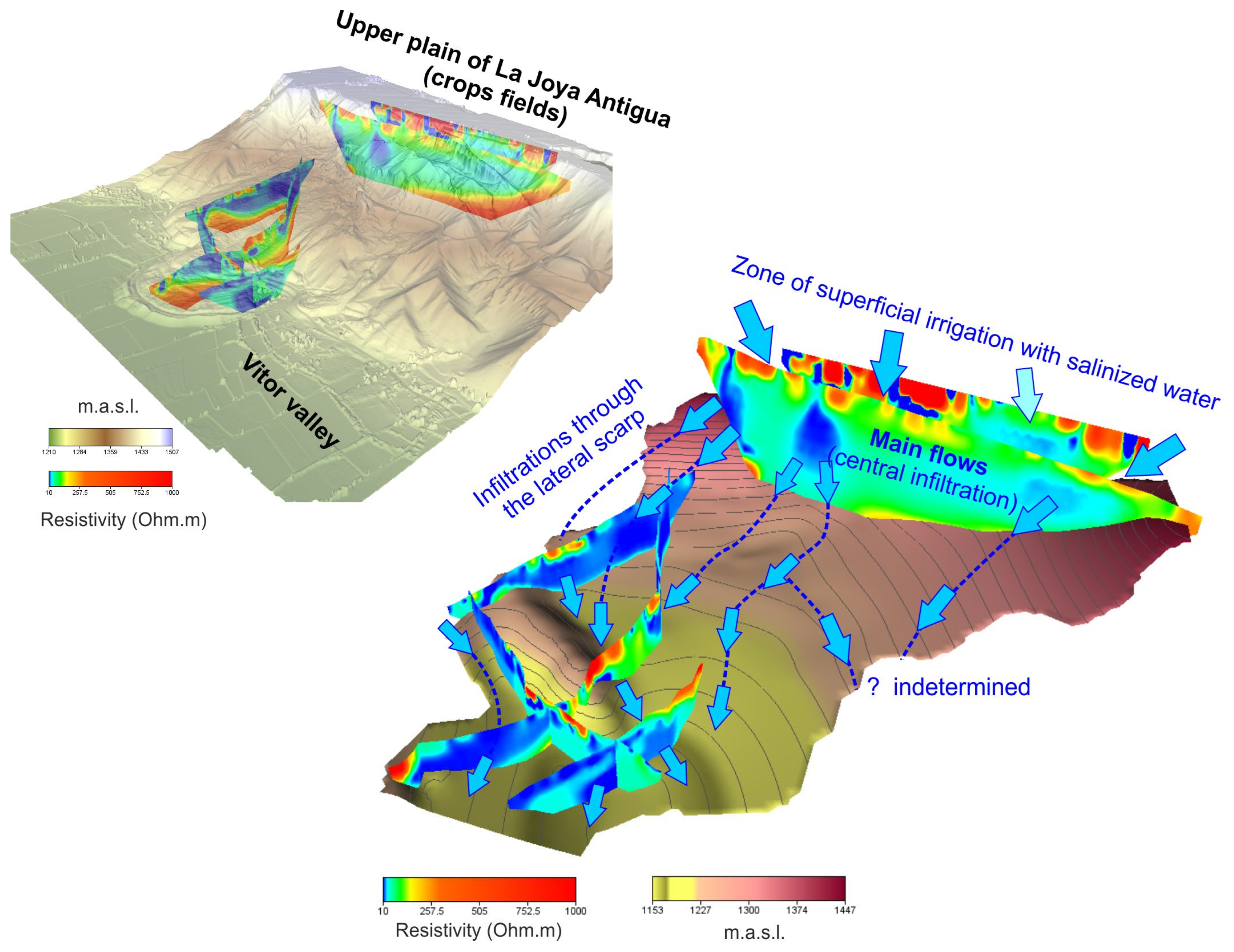
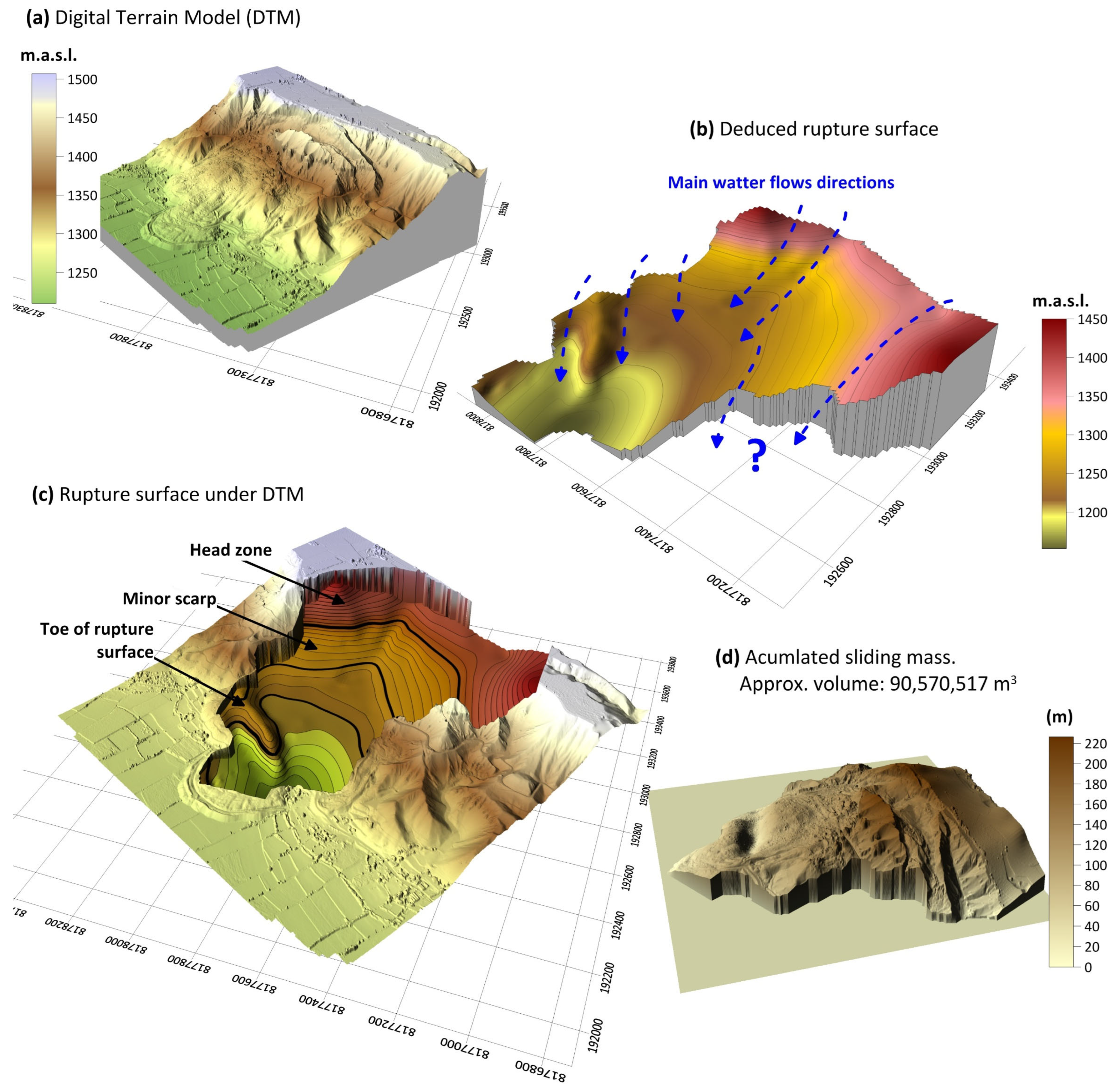
| Profiles | Sensors Spacing | # of Sensors | Sensor Array | Total Length | Reached Depth | |
|---|---|---|---|---|---|---|
| ERT survey | 2D-ERT01 | Electrodes at 40 m | 33 | Pole-Dipole | 640 m | 160 m |
| 2D-ERT02 | Electrodes at 30 m | 35 | Pole-Dipole | 510 m | 120 m | |
| 2D-ERT03 | Electrodes at 25 m | 45 | Pole-Dipole | 550 m | 140 m | |
| 2D-ERT04 | Electrodes at 25 m | 29 | Pole-Dipole | 350 m | 90 m | |
| 2D-ERT05 | Electrodes at 30 m | 27 | Pole-Dipole | 390 m | 100 m | |
| 2D-ERT06 | Electrodes at 50 m | 45 | Pole-Dipole | 1100 m | 220 m | |
| 2D-ERT07 | Electrodes at 50 m | 35 | Pole-Dipole | 850 m | 200 m | |
| SVP survey | 2D-SVP01 | Geophone at 5 m | 2 × 24 of 20 Hz | 13 shots | 420 m | 240 m |
| 2D-SVP02 | Geophone at 5 m | 2 × 24 of 20 Hz | 19 shots | 600 m | 70 m |
| 2D -Sections | # of Iterations | Abs. Error | Reached Depth (m) | |
|---|---|---|---|---|
| ERT survey | 2D-ERT01 | 8 | 8.9 | 167 |
| 2D-ERT02 | 7 | 8.6 | 120 | |
| 2D-ERT03 | 9 | 6 | 125 | |
| 2D-ERT04 | 10 | 8.8 | 95 | |
| 2D-ERT05 | 9 | 9.8 | 126 | |
| 2D-ERT06 | 10 | 12.3 | 215 | |
| 2D-ERT07 | 10 | 19.8 | 210 |
| Profile | Normalized RMS Error | # Traces Modeled | # of Iterations | |
|---|---|---|---|---|
| P-wave seismic survey | 2D-SVP01 | 8.5 (%) | 279 | 8 |
| 2D-SVP02 | 9.1 (%) | 281 | 7 |
Disclaimer/Publisher’s Note: The statements, opinions and data contained in all publications are solely those of the individual author(s) and contributor(s) and not of MDPI and/or the editor(s). MDPI and/or the editor(s) disclaim responsibility for any injury to people or property resulting from any ideas, methods, instructions or products referred to in the content. |
© 2023 by the authors. Licensee MDPI, Basel, Switzerland. This article is an open access article distributed under the terms and conditions of the Creative Commons Attribution (CC BY) license (https://creativecommons.org/licenses/by/4.0/).
Share and Cite
Huayllazo, Y.; Infa, R.; Soto, J.; Lazarte, K.; Huanca, J.; Alvarez, Y.; Teixidó, T. Using Electrical Resistivity Tomography Method to Determine the Inner 3D Geometry and the Main Runoff Directions of the Large Active Landslide of Pie de Cuesta in the Vítor Valley (Peru). Geosciences 2023, 13, 342. https://doi.org/10.3390/geosciences13110342
Huayllazo Y, Infa R, Soto J, Lazarte K, Huanca J, Alvarez Y, Teixidó T. Using Electrical Resistivity Tomography Method to Determine the Inner 3D Geometry and the Main Runoff Directions of the Large Active Landslide of Pie de Cuesta in the Vítor Valley (Peru). Geosciences. 2023; 13(11):342. https://doi.org/10.3390/geosciences13110342
Chicago/Turabian StyleHuayllazo, Yasmine, Rosmery Infa, Jorge Soto, Krover Lazarte, Joseph Huanca, Yovana Alvarez, and Teresa Teixidó. 2023. "Using Electrical Resistivity Tomography Method to Determine the Inner 3D Geometry and the Main Runoff Directions of the Large Active Landslide of Pie de Cuesta in the Vítor Valley (Peru)" Geosciences 13, no. 11: 342. https://doi.org/10.3390/geosciences13110342
APA StyleHuayllazo, Y., Infa, R., Soto, J., Lazarte, K., Huanca, J., Alvarez, Y., & Teixidó, T. (2023). Using Electrical Resistivity Tomography Method to Determine the Inner 3D Geometry and the Main Runoff Directions of the Large Active Landslide of Pie de Cuesta in the Vítor Valley (Peru). Geosciences, 13(11), 342. https://doi.org/10.3390/geosciences13110342








